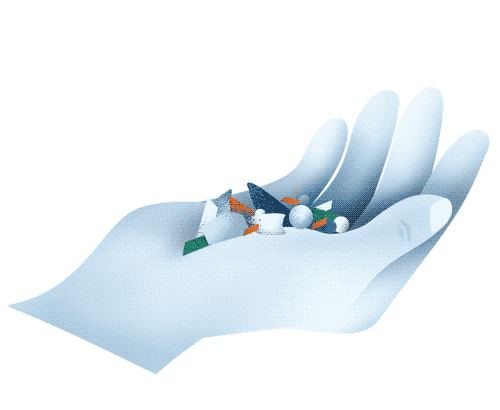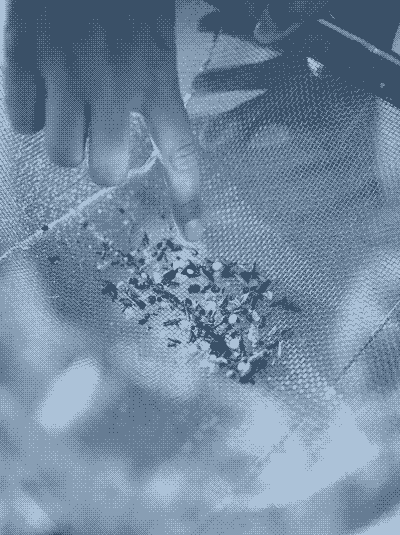MICROPLASTICS AND PLASTIC PELLETS
the scourges of the ocean

microplastic, huge pollution
Microplastics are plastic particles smaller than 5 mm, invisible to the naked eye. They are one of the most harmful and persistent consequences of plastic pollution and pose a growing threat to the environment and human health.
Found everywhere, from the air we breathe to the depths of the ocean, in the water we drink and the food we eat, microplastics and nanoplastics are an uncontrollable and unprecedented source of pollution.
There are several types of microplastics:
- Microplastics intentionally added to many everyday products to improve their texture, for example (such as cosmetics or cleaning products)
- Micro- and nanoparticles from plastic waste decomposing in the ocean and those resulting from the degradation of various materials, such as textile fibres or residual particles linked to tyre abrasion
- Industrial plastic pellets Industrial plastic pellets are small beads used as raw material in the manufacture of most plastic objects. Their small size (less than 5 mm) and industrial failures cause them to be dispersed into the environment during production, transport, storage and recycling
These avoidable leaks contribute to plastic pollution and pose a particular threat to aquatic ecosystems.
According to the European Commission, European industry loses around 180,000 tonnes of pellets annually, making this pollution the second largest source of primary microplastics.
Persisting in the environment for hundreds of years, these pellets cause irreversible damage to biodiversity. As they fragment, they enter the food chain in the form of microparticles, exposing wildlife and potentially humans to chemical contaminants from plastic
Our approach and requirements

1.
Towards a ban on microplastics intentionally
added to household and cosmetic products
In response to the widespread use of microplastics and the environmental damage they cause, Surfrider Europe has led a determined advocacy campaign that has resulted in a major regulatory measure.
In September 2023, following strong campaigning by Surfrider Europe, the Plastic Soup Foundation and the Rethink Plastic Alliance, the European Commission adopted a new restriction on microplastics intentionally added to cosmetics and other products. This ban will be fully effective by 2035.
This regulatory victory is based on solid arguments put forward by Surfrider to the European institutions: microplastics in cosmetics are a source of massive pollution with dramatic consequences for the environment and pose proven risks to human health, even though no robust studies demonstrate their real usefulness in improving the performance of cosmetics and alternatives without microplastics already exist and are perfectly viable.
To achieve this historic result, Surfrider teams made sustained efforts over the long term: sending open letters to European decision-makers, raising public awareness about the dangers of microplastics to aquatic ecosystems, mobilising citizens, and working closely with other European organisations.
The downsides
Today, there are still some grey areas in this regulation.
While the restriction currently prohibits glitter sold separately, it does not specify anything about glitter used in items such as self-tanning products, make-up or shower gels.
Furthermore, this specific aspect is currently the subject of litigation, with a Christmas decoration company challenging the ban.
In response, the Commission has updated its website to exempt most uses of glitter from the ban, bowing to industry lobbying.
Our mission: constant vigilance
Surfrider Europe is now keeping a close watch on this issue.
We are doing our utmost to closely monitor the development of the guidelines that the European Commission is currently drafting, sometimes in a lack of transparency and without consulting NGOs, which risk reducing the scope of the restriction.
At the same time, we are ensuring that Member States ensure that the restrictions are properly enforced and take appropriate action in cases of non-compliance.
2.
Bringing the issue of IPG pollution to light
Industrial plastic pellets are the third largest source of microplastic pollution in the EU.
This systemic pollution affects the entire value chain and is the result of widespread malfunctions or poor practices.
Action strategy: from awareness-raising to regulation
In order to combat the scourge of plastic pellets pollution effectively and concretely, it is essential to act at the source and target the industries responsible directly. The most effective and reliable way to achieve this is through binding European regulations.
This approach required Surfrider to work methodically on several fronts: raising awareness of the problem through extensive communication and awareness-raising efforts, documenting the scourge by drafting rigorous technical reports, and bringing the issue to the attention of institutions by asking for it to be placed on the political agenda.
Historic victory: placing the issue on the European agenda
In April 2021, Surfrider Europe scored a decisive victory with the publication of the ‘Plastic Giants’ report, playing a key role in putting the issue of plastic pellets on the agenda and advancing European legislation.
This in-depth documentation work made it possible to activate numerous levers to make decision-makers aware of the threat that plastic pellets pose to the environment, particularly the ocean.
Concrete results: the adoption of national and European regulations
Surfrider Foundation Europe has made a decisive contribution to the adoption of French and then European regulations on industrial plastic pellets.
At European level, in October 2023, the European Commission proposed the first measures to prevent microplastic pollution caused by the unintentional release of plastic pellets.
In April 2025, the Council and the European Parliament reached a compromise to adopt the future regulation on the prevention of plastic pellet losses in the environment.
Some key figures on microplastic pollution
Going further
